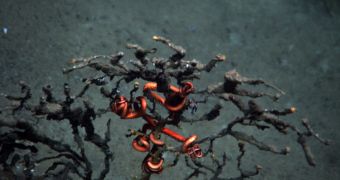The Deepwater Horizon/BP oil spill that lasted from April 20 until July 15, 2010, had far-reaching effects on marine ecosystems. In a recent investigation, experts supported by the US National Science Foundation (NSF) found that deepwater corals were also severely affected.
The investigation was conducted in the Gulf of Mexico, where the world's most massive accidental oil spill occurred. The ruptured wellhead that caused the leak created a “kill zone” covering 80 square miles (201 square kilometers), but the actual oil covered a much larger surface.
For the new study, investigators at the Pennsylvania State University (PSU), the leaders of the multi-institution research team, used a number of autonomous underwater vehicles (AUV), as well as the submarine Alvin.
Details of their research were published in the latest issue of the esteemed journal Proceedings of the National Academy of Sciences (PNAS). The group came across important amounts of petroleum hydrocarbons, experts add.
In order to figure out where the oil was coming from, scientists used an investigation technique called comprehensive two-dimensional gas chromatography. Oil from the Deepwater Horizon wellhead was discovered to have significant influence even at great depths.
“The biological communities in the deep Gulf of Mexico are separated from human activity at the surface by 4,000 feet of water,” explains scientist Helen White, a chemist at the Haverford College and the lead author of the PNAS paper.
Experts from the Woods Hole Oceanographic Institution (WHOI), Temple University and the US Geological Survey (USGS) were also involved in this research.
“We would not expect deep-water corals to be affected by a typical oil spill. But the sheer magnitude of the Deepwater Horizon oil spill makes it very different from a tanker running aground and spilling its contents,” White adds.
“Because of the unprecedented nature of the spill, its effects are more far-reaching than those from smaller spills on the surface,” she goes on to say. A total of nine sites were analyzed during this research, inside a radius of 20 kilometers (12.4 miles) from the ruptured wellhead.
Most of the coral communities there were safe, but the same was not valid for an area located about 11 kilometers (6.8 miles) south of the wellhead. A brown flocculent material covered reefs at this location. The organisms showed signs of advanced cellular damage.
“As soon as the ROV got close enough to the community for the corals to come into clear view, it was obvious that something was wrong. There was too much white and brown, and not enough color on the corals and brittle stars,” says PSU expert Charles Fisher, the leader of the research team.
“Ongoing research in the Gulf will improve our understanding of the resilience of these isolated coral communities and the extent to which they are affected by human activity. Oil had a visible effect on the corals, and it's important to determine whether they can rebound,” White concludes.

 14 DAY TRIAL //
14 DAY TRIAL //